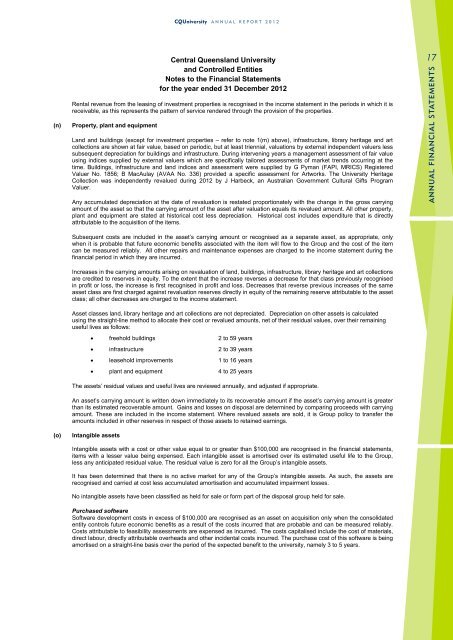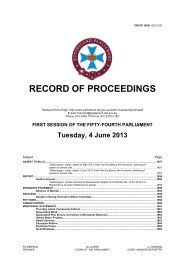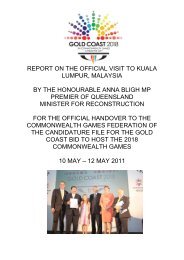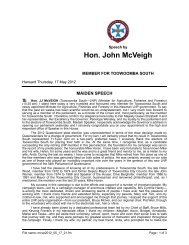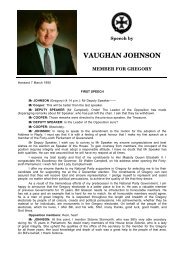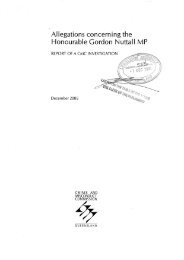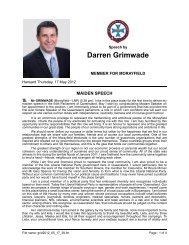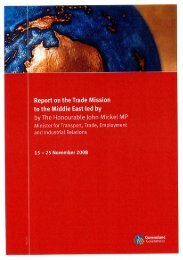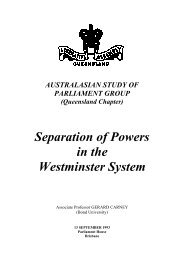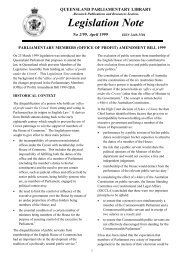CQUniversity Annual Report - Central Queensland University
CQUniversity Annual Report - Central Queensland University
CQUniversity Annual Report - Central Queensland University
Create successful ePaper yourself
Turn your PDF publications into a flip-book with our unique Google optimized e-Paper software.
<strong>CQ<strong>University</strong></strong> ANNUAL REPORT 2012<br />
(n)<br />
(o)<br />
<strong>Central</strong> <strong>Queensland</strong> <strong>University</strong><br />
and Controlled Entities<br />
Notes to the Financial Statements<br />
for the year ended 31 December 2012<br />
Rental revenue from the leasing of investment properties is recognised in the income statement in the periods in which it is<br />
receivable, as this represents the pattern of service rendered through the provision of the properties.<br />
Property, plant and equipment<br />
Land and buildings (except for investment properties – refer to note 1(m) above), infrastructure, library heritage and art<br />
collections are shown at fair value, based on periodic, but at least triennial, valuations by external independent valuers less<br />
subsequent depreciation for buildings and infrastructure. During intervening years a management assessment of fair value<br />
using indices supplied by external valuers which are specifically tailored assessments of market trends occurring at the<br />
time. Buildings, infrastructure and land indices and assessment were supplied by G Pyman (FAPI, MRICS) Registered<br />
Valuer No. 1856; B MacAulay (AVAA No. 336) provided a specific assessment for Artworks. The <strong>University</strong> Heritage<br />
Collection was independently revalued during 2012 by J Harbeck, an Australian Government Cultural Gifts Program<br />
Valuer.<br />
Any accumulated depreciation at the date of revaluation is restated proportionately with the change in the gross carrying<br />
amount of the asset so that the carrying amount of the asset after valuation equals its revalued amount. All other property,<br />
plant and equipment are stated at historical cost less depreciation. Historical cost includes expenditure that is directly<br />
attributable to the acquisition of the items.<br />
Subsequent costs are included in the asset’s carrying amount or recognised as a separate asset, as appropriate, only<br />
when it is probable that future economic benefits associated with the item will flow to the Group and the cost of the item<br />
can be measured reliably. All other repairs and maintenance expenses are charged to the income statement during the<br />
financial period in which they are incurred.<br />
Increases in the carrying amounts arising on revaluation of land, buildings, infrastructure, library heritage and art collections<br />
are credited to reserves in equity. To the extent that the increase reverses a decrease for that class previously recognised<br />
in profit or loss, the increase is first recognised in profit and loss. Decreases that reverse previous increases of the same<br />
asset class are first charged against revaluation reserves directly in equity of the remaining reserve attributable to the asset<br />
class; all other decreases are charged to the income statement.<br />
Asset classes land, library heritage and art collections are not depreciated. Depreciation on other assets is calculated<br />
using the straight-line method to allocate their cost or revalued amounts, net of their residual values, over their remaining<br />
useful lives as follows:<br />
freehold buildings 2 to 59 years<br />
infrastructure 2 to 39 years<br />
leasehold improvements 1 to 16 years<br />
plant and equipment 4 to 25 years<br />
The assets’ residual values and useful lives are reviewed annually, and adjusted if appropriate.<br />
An asset’s carrying amount is written down immediately to its recoverable amount if the asset’s carrying amount is greater<br />
than its estimated recoverable amount. Gains and losses on disposal are determined by comparing proceeds with carrying<br />
amount. These are included in the income statement. Where revalued assets are sold, it is Group policy to transfer the<br />
amounts included in other reserves in respect of those assets to retained earnings.<br />
Intangible assets<br />
Intangible assets with a cost or other value equal to or greater than $100,000 are recognised in the financial statements,<br />
items with a lesser value being expensed. Each intangible asset is amortised over its estimated useful life to the Group,<br />
less any anticipated residual value. The residual value is zero for all the Group’s intangible assets.<br />
It has been determined that there is no active market for any of the Group’s intangible assets. As such, the assets are<br />
recognised and carried at cost less accumulated amortisation and accumulated impairment losses.<br />
No intangible assets have been classified as held for sale or form part of the disposal group held for sale.<br />
Purchased software<br />
Software development costs in excess of $100,000 are recognised as an asset on acquisition only when the consolidated<br />
entity controls future economic benefits as a result of the costs incurred that are probable and can be measured reliably.<br />
Costs attributable to feasibility assessments are expensed as incurred. The costs capitalised include the cost of materials,<br />
direct labour, directly attributable overheads and other incidental costs incurred. The purchase cost of this software is being<br />
amortised on a straight-line basis over the period of the expected benefit to the university, namely 3 to 5 years.<br />
17<br />
ANNUAL FINANCIAL STATEMENTS


